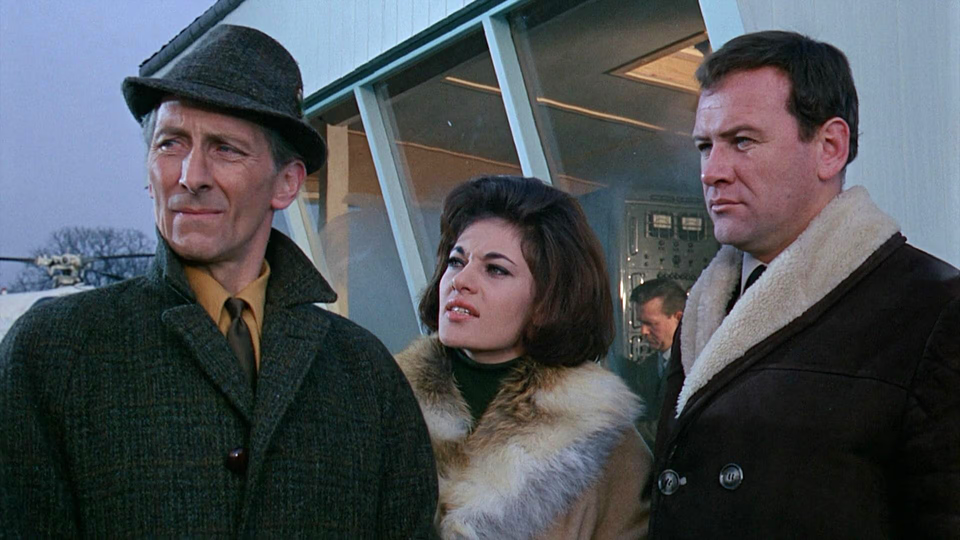Island of Terror

When is a Hammer film not a Hammer film?
Island of Terror packs all the ingredients: an atmospheric United Kingdom location, a horrific menace, gruesome murders, Peter Cushing, and director Terence Fisher, but it’s actually from another independent British studio, Planet Film Productions.
Edward Judd and Peter Cushing play scientists summoned to Petrie’s Island, just off the coast of Ireland, after the local constable finds a body bereft of bones. They soon discover the island is under siege from indestructible mollusks that subsist on calcium phosphate.
So far, so Hammer, until Judd and Cushing pull up to a gothic-looking mansion that housed a reclusive scientist and Cushing remarks, “Good lord, it looks like Wuthering Heights.”
Indeed, the script, by Edward Mann and Al Ramsen, takes a Quatermass story and injects a streak of self-aware humor absent in Nigel Kneale’s Hammer scripts, resulting in a more entertaining outing. It also avoids the usual plot machinations, like the villagers distrusting the scientists, or having Judd’s romantic interest conveniently wander into peril, keeping the running time under ninety minutes.
According to Tony Dalton in Terence Fisher: Master of Gothic Cinema, Planet Film hired Fisher based on the success of 1964’s The Earth Dies Screaming, but Fisher was loath to take the job as he detested the science-fiction genre. Fortunately, he detested sitting idle even more, so agreed to a two-picture deal (the other being 1967’s Night of the Big Heat).
Once onboard, Fisher requested some minor script changes to beef up some supporting characters, then recruited Cushing.
For Cushing fans, this film proves a treat. As co-lead, Cushing doesn’t have to carry the picture, and this translates into a noticeably more relaxed performance.
In Peter Cushing: A Life in Film, David Miller reports Cushing shot the film while appearing on stage in the farce Thark. Perhaps a fortuitous coincidence, as his Island of Terror character gets all the aforementioned self-aware humor. Besides the Wuthering Heights quip, he gets a great line when Judd’s romantic interest balks at waiting in the car and Cushing says, “I wouldn’t want to stay out here alone. It’s too damned creepy.”
Alongside Cushing, Judd holds his own, displaying terrific range during a scene where he’s rushing to repair a car as the creatures draw closer. In a subtle detail that sells the scene, as he hurries to close the hood, you can see his hands shaking. A nice touch.
The supporting cast shines too. Niall MacGinnis, sporting a weather-beaten face as the local village leader, doesn’t have much to do, but proves welcome nonetheless.
Fisher shot the film at Pinewood Studios in London, and the cold, overcast weather during the production lends the outdoor scenes a palpable sense of damp, dreary dread that suits the material.
The weak link is the creature design, which looks both cheap and artificial, comparable to the effects on the Star Trek or later Doctor Who television shows. I cut them some slack here, given the threat comes from the volume of creatures (they multiply every few hours) and that Fisher often films them outside (making terrific use of the dark, isolated country), the production needed a design simple and cheap enough to facilitate multiple copies, yet sturdy enough to withstand the outdoor elements.
To compensate, Fisher gives us a shot of the creatures multiplying, where one splits into two via a gooey mass oozing what resembles spaghetti. It’s surprisingly unsettling and gross. Another surprise comes later with a dismemberment that resulted in a few seconds of spurting blood being excised from the UK cut.
Indeed, despite hating the genre, Terence Fisher’s effort proves more entertaining than Hammer’s Quatermass and the Pit, released the following year. It’s the best Hammer sci-fi movie Hammer didn’t make.